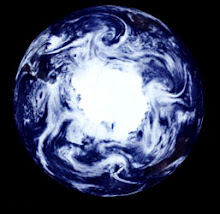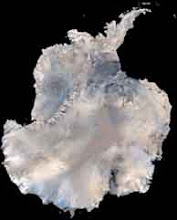+001.JPG)
Interesting Hypotheses:



So what is REALLY happening?
The area of Antarctica where this photo was taken is the peninsula area. This is the most delicate ecosystem in Antarctica because it is north  enough that the temperatures can change quite drastically.
enough that the temperatures can change quite drastically.
Therefore, water flows during the majority of the Antarctic summer and icebergs like those portrayed in movies such as The Day After Tomorrow are formed rather regularly. Icebergs like these keep most of their mass below water. The water that surrounds the icebergs is warmer then the ice, so it makes sense that the ice will melt from the bottom up (which is the reverse of how ice freezes). When the underside of giant icebergs begins to melt the bergs can become very unstable.
A good experiment we can do to test this hypothesis is to find an ice cube and melt it in a glass of warm water. How does the ice melt? From the bottom or top? Does it start rocking around if you shake the glass slightly? Could you imagine that in a storm a big half melted iceberg could flip over?
That is exactly what we think happened in this case. The iceberg that was already melted on the bottom by the warmer water circling around it, became unstable, and in a storm it flipped over. The formation looks like it has been shaped by the wind or that it even was flowing water. But to the contrary the ice was melted due to the surrounding water!
Does it make sense? What do you think?
Thank you for your comments, especially Victoria of Mr. Hector's 3rd grade class. Keep reading and hypothesising and we can all come up with more answers to the really important questions!
Looking Down.
 There are few things that I expected of Antarctica; one was that I would see things, while looking up, that I have never seen before. I was right about that and when I first arrived in the Dry Valleys my eyes were glued to the mountain ranges and glaciers. For the past few blogs I have attempted to convey some of the wonders of these landscapes, from Mt Erebus to the ice bergs floating at sea, but what I wasn’t prepared for was the astounding wonder of all the things there are to see closer to the ground . In short, Antarctica is one of those few places on earth where looking down can be just as interesting as looking up—here’s why.
There are few things that I expected of Antarctica; one was that I would see things, while looking up, that I have never seen before. I was right about that and when I first arrived in the Dry Valleys my eyes were glued to the mountain ranges and glaciers. For the past few blogs I have attempted to convey some of the wonders of these landscapes, from Mt Erebus to the ice bergs floating at sea, but what I wasn’t prepared for was the astounding wonder of all the things there are to see closer to the ground . In short, Antarctica is one of those few places on earth where looking down can be just as interesting as looking up—here’s why.
 I work on lakes in the Dry Valleys. Every day we are walking across frozen lakes to get out to the Polar Haven, where we do research. Sometimes we can find clumps of agal mats (shown left and below) that represent the life that survives underneath the ice of Lake Chad. These algal mats float to the surface of the lakes during the Antarctic summer when Lake Chad is finally ice free.
I work on lakes in the Dry Valleys. Every day we are walking across frozen lakes to get out to the Polar Haven, where we do research. Sometimes we can find clumps of agal mats (shown left and below) that represent the life that survives underneath the ice of Lake Chad. These algal mats float to the surface of the lakes during the Antarctic summer when Lake Chad is finally ice free. The texture of the ice on each of the lakes is so different that it is almost possible to discern which lake you are on solely by looking down at the lake ice. Parts of Bonney and all of Chad are so glassy that you can see down to the rocks that scatter the bottom of the lakes. They also have hidden caves in the layers of ice, which make walking treacherous to the unaware, but which also turn the lake into a mysterious land of secret forts and hideaways.
The texture of the ice on each of the lakes is so different that it is almost possible to discern which lake you are on solely by looking down at the lake ice. Parts of Bonney and all of Chad are so glassy that you can see down to the rocks that scatter the bottom of the lakes. They also have hidden caves in the layers of ice, which make walking treacherous to the unaware, but which also turn the lake into a mysterious land of secret forts and hideaways. 

 in the ice.
in the ice.The wind howls through the valleys at such speeds that rocks and glaciers alike are carved and molded into ventifacts that scatter the ground and the sides of mountains. These huge sculptures are shaped by the wind that howls through the valleys whipping our faces and freezing uncovered fingers. Smaller stones also cover the desert ground and occasionally flurries of snow whip through creating a thin blanket of white on all of the surfaces.

Mystery of the Ice...
 Check out this Antarctic Wave....
Check out this Antarctic Wave....The temperature is below freezing for the majority of the year and streams only flow for the two months of summer. However, in this picture you can see what looks like a frozen wave.
 YOU BE THE SCIENTIST:
YOU BE THE SCIENTIST:Question: What caused the formation of this ice structure?
Create a HYPOTHESIS and make sure you are able to tell us WHY your hypothesis is realistic.
Remember that having a hypothesis is the most important part. The correctness of your hypothesis doesn’t really matter, BUT you do need to have a REASON for your hypothesis (so give us the reason)!
Please respond to this post using the comments button and leave your name, school, and age in the spot of a ‘nick name.’





